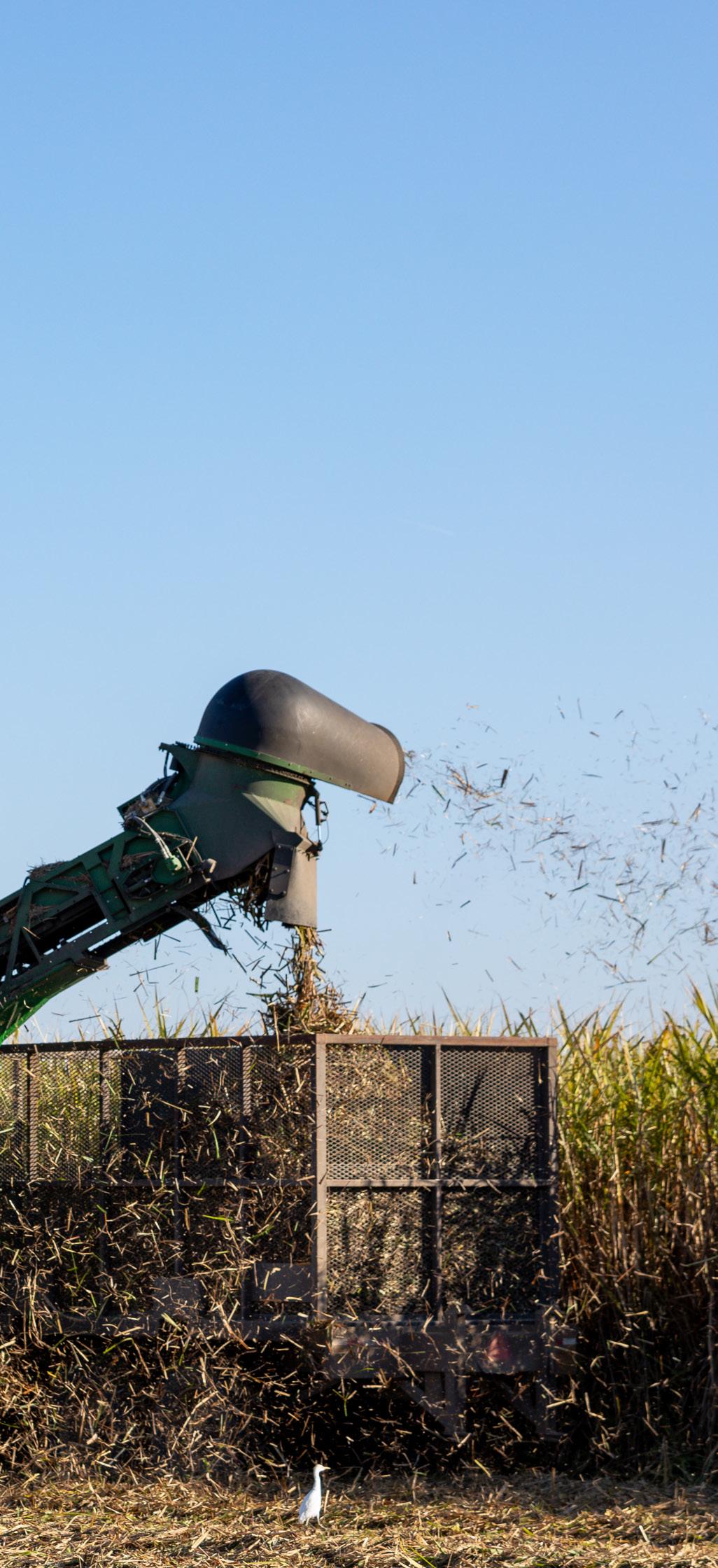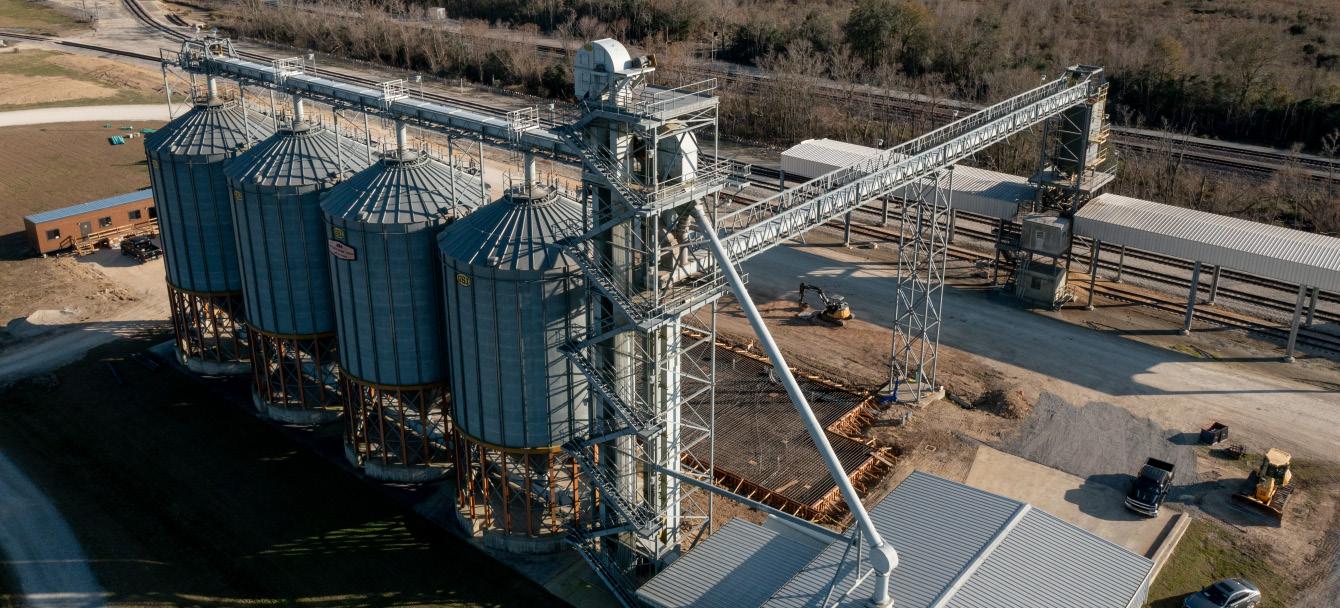
6 minute read
Agriculture
by LABI_Biz
Collin Richie
A state-of-the-art John Deere cane harvester separates leaf trash from the harvest.
As global consumption outpaces supply, Louisiana’s years of investment in science and technology could pay off
BY MARIE CENTANNI
Near the banks of the Bayou Teche, a giant green John Deere cane harvester methodically combs up and down rows of sugarcane, chopping the sugary stalks down to eight-inch segments, or “billets,” as it goes. In the rear of the mammoth machine, a sophisticated fan whirs at varying speeds, modulating its intensity based on a series of five different input measurements to accurately separate what Mike Duplantis calls “leaf trash” from the harvest.
“In the past we didn’t have technology to monitor the amount of trash being extracted,” says Duplantis, factory manager at John Deere Thibodaux, where the cane harvester is manufactured. “Smart Clean has come in and we can now, through technology, optimize the harvest. The stalks go into a chamber as it’s cut, the billets fall down, the leaf trash is lighter and gets sucked up through the fan. Everybody wants to remove as much leaf trash as possible.”
Less leaf trash means a cleaner harvest, and that means a whole lot to growers sending their cane to the mill. “Once it gets to the mill and you grind up the billets with any leaf trash,” he says, “the trash has zero sugar content, so it acts like a sponge. If you’re crushing the cane stalk and trying to get that juice, any additional trash is soaking up the sugar.”
Duplantis says leaf trash also adds extra weight—and cost—to the wagons transporting the cut cane. “One of the big costs to a farm is the freight of getting sugarcane to the mill, so if I’m shipping a load with a fair amount of leaf trash, the density is lower, there’s less weight per cubic foot. If it’s just cane, my density goes up. So, I can ship a denser load and also maximize the amount of product I can put in the trailer without going overweight.”
That’s something else the high-tech harvester does, by the way. It measures the billets going into the wagon to get as close as possible to the weight limit without going over. In other words, very little waste, very little error, very much maximizing the sugarcane farmer’s investment.
And that’s not the only tech toy Duplantis has in his toybox. How about a variable rate fertilizer, only applying fertilizer where it’s needed? How about herbicides, with yet another machine that identifies and only sprays weeds in the field? Technology like this continues to advance, saving farmers input costs on a finite piece of land, including the newest advancement revealed in January at the Consumer Electronics Show in Las Vegas—the world’s first fully autonomous tractor, which could solve the challenge of a labor shortage. And it doesn’t need a lunch break.
Louisiana Agriculture Commissioner Mike Strain says that maximum yield for minimum investment is just one reason our state is poised to profit in the world’s evolving food supply chain.
“The height of innovation is now upon us,” says Strain. “If you look at the continuing growing demand to produce


At the South Louisiana Rail Facility in Lacassine, 200 rice farmers invested in their own rail export operation.
more for a growing population, we have limited land. It’s pushing the evolution of science and technology to the forefront, how to produce more with fewer inputs. A huge key is the fact that the world demand is outpacing supply, and that’s going to continue driving prices and innovation, and the value will continue to grow in a rapid fashion.”
Strain says as the nation looks to increase its supply to meet that growing demand, Louisiana is at a unique advantage given our generations of deep-rooted farming knowledge coupled with the technology that’s been developed, especially via the LSU AgCenter system at places like the Rice Research Station in Crowley, where farmers pool their money to invest in research. He says there’s very little lapse between what’s developed in the laboratory and what’s applied in the field, to our advantage. But he says our impending success will also come because of our capacity to export easily, and investments made in our port infrastructure and dredging major waterways like the Mississippi River.
“Companies are investing in export facilities up and down the river,” says Strain. “We’re poised now to go from 60% to over 70% of exported grain from the U.S. exported from Louisiana ports. That’s huge because they see what’s coming.”
Farmers are also pooling their resources in the export facilities sector, like at the South Louisiana Rail Facility, the work of 200 rice farmers who invested in their own rail export operation in Lacassine, transporting to ocean-going vessels via the Port of Lake Charles. Over the past three years, they’ve exported 175,000 tons of rice from Louisiana and east Texas, and now they’re
adding a processing facility with technology that’s not been seen in the Western hemisphere—“Farm to Fork” traceability.
“Our business model was to load some rail cars,” says Mark Pousson, who does sales and marketing for SLRF. “Fast forward 10 years, we’re moving rice along with the largest traders in the world.”
Pousson says the new sustainability/ traceability technology will ensure their product is a world leader in meeting the new demands of a new breed of consumer. “The new generations require that in consumption,” he says. “The younger generation consumer is trending, and they just want to know more about where their food comes from.”
“You’re going to know where that farmer grew that rice, when it got shipped, how it was treated all the way through the process to the one-pound bag on the shelf. The consumer is going to be able to pick up that bag of rice at the store, take out their cell phone and pull up a video clip of where that rice came from, how it was treated and taken care of.”
The growing export operation, delving into new technology, will add ten new jobs to the site, but more importantly will continue to sustain the investing farmers, their families and employees.
“Louisiana is uniquely positioned to take full advantage of the growing demand as we are the major export hub of agriculture commodities for the United States,” says Strain. “The vast majority of our production is exported from Louisiana. In addition, we have ample water, and the most fertile land in America. It doesn’t get any better than that alluvial soil and access to ports. We just need to work on our local roads and bridges.”
And that, says Strain, is the missing link, as the majority of roads and bridges are in rural Louisiana, traversed by farmers and their products headed to the mill or market. He says it’s a challenge Louisiana must solve to truly realize the economic potential of our agriculture advantage. “Infrastructure is the key to economic prosperity,” he says, “because it is imperative you move the natural resource from where it is harvested or severed to its point of manufacturing or export. That’s a fundamental.”

Tim Mueller
Louisiana Agriculture Commissioner Mike Strain




